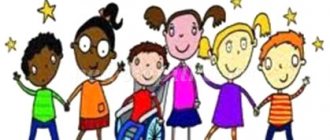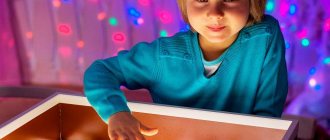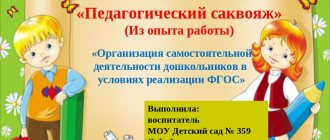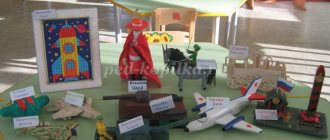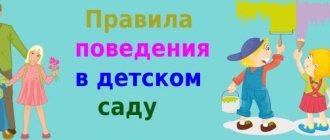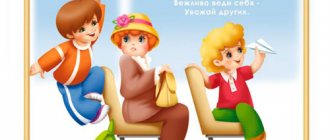Indications for use of the method
For small children, everything is a game. Therefore, it is impossible to highlight significant evidence, since games are the main leisure time for children. When children play, they are in a good mood and do not regard it as something unpleasant and repulsive. Game therapy products are effective in the following cases:
- phobias;
- unsociability, isolation;
- aggression towards others and animals;
- disobedience or excessive obedience;
- problems in relationships with parents, brothers and sisters, etc.;
- retardation in speech development;
- bad habits (for example, chewing a pencil while drawing);
- constant stress;
- problems with academic performance;
- problems with reading. Source: O'Connor K. Theory and practice of play psychotherapy. - St. Petersburg, 2002.
Who is better for a child to play with?
It is impossible to answer this question unambiguously. It all depends on the goals described above. If it is necessary to reveal potential or slightly correct behavior, then it will be comfortable and adaptive to do this with parents. After all, they are the ones who know their baby better than anyone else and will find an approach to him. And the child will be more comfortable playing with relatives. Regular trips to the office with a “Psychologist” sign can themselves cause stress, which is unnecessary if the baby is just a little capricious, for example.
Parents cannot always cope with psychological disorders on their own due to many factors: subjectivity, lack of appropriate education, time, desire, and others. Therefore, in such cases, it is better to contact a play therapist who, if necessary, will involve both mom and dad in the game or teach them how to play at home.
Types and forms of play therapy
Depending on the psychological principles, the following types of techniques are distinguished:
- to build relationships;
- individual;
- group;
- response;
- primitive;
- and etc.
Depending on the toys used and the characteristics of the techniques, there are many types of play therapy. Let's look at the main ones:
- Sand . Its goal is to allow the child to open up; this technique is most effective when working with children with mental development delays. Sand play therapy promotes the development of imagination, emotions, fine motor skills, speech, it allows you to overcome fear, aggression, excessive activity, and anxiety. You can read more in our separate article about sand therapy.
- Fairy tale therapy . The general characteristic of such play therapy is treatment with a fairy tale. One of the most effective and accessible methods for correcting a child’s behavior and consciousness. In this type of therapy, therapeutic fairy tales are read to children. These are special stories that illustrate the experiences and problems of a child, his difficulties in everyday life, and also contain instructive conclusions and unobtrusive morals. Thanks to fairy tale therapy, the child sees that there are many ways to achieve his goal, solve seemingly difficult problems, his creative potential is revealed, self-confidence and self-control appear. Such therapy can be carried out on children from a very early age, when they already understand speech. For older children, the plots become more complex.
- Puppet therapy . A method of treatment with dolls, used to develop self-expression, correct relationships with parents, and self-regulation.
- Relationship therapy . The main thing is to approach the child as an individual who can control himself and has an impressive reserve of internal strength. Children learn to understand their feelings, thoughts, experiences, and recognize themselves as loved and loving people.
- Chess therapy . It is creativity, competition, and learning strategies at the same time.
Different games for different purposes
Unfortunately, there is no one universal game that would allow you to get rid of childhood problems. The choice of game depends on the source of the disorder and its depth. It is best if a psychologist selects suitable leisure time. But there is no harm from games, so you can use the recommendations described below.
Several conditions must be met for the game to be successful.
- Such a pastime should be interesting not only for a child, but also for an adult. Children always sense insincerity. And if they know that their parents play with them because they have to, and not because they want to, then the entire therapeutic effect may come to naught. The sincere pleasure of all participants is the key to success.
- The game should be spontaneous. For kids this is of particular importance. If a child plays according to some schedule, then for him it will not be entertainment, but work.
- The game must be voluntary. In general, this is obvious from the previous paragraphs. Entertainment under pressure is no longer such.
Games to improve psychological well-being
Children feel calm when they know that someone needs them and is interesting. The easiest way to show this is through the following well-known games:
- blind man's buff;
- tag;
- hide and seek;
- obstacle course.
In all games, it is important to give in a little, if it is clear that the baby is not coping, to encourage and praise for success.
Games that help correct aggression
For children who show aggression, it is important to show in contrast that there is another model of behavior, and also that any dispute should end on a positive note. These games can be played from the age of two.
- War game. A child and an adult throw various safe objects at each other: pillows, wads of paper, plush toys, using shields and shelters. And they end the fight with a draw and hugs.
- Cats. The baby and the adult take turns turning together, either into kind, purring and caressing cats, or into angry and hissing ones. Instead of cats there can be dogs, hedgehogs and any other animals.
Games aimed at relieving tension and relaxation
The main goal of eliminating these parameters is a change in brain activity and physical calm.

- The sea is agitated once. The well-known game works great for distraction and relaxation. The adult says: the sea worries once, the sea worries two, the sea worries three, the sea (terrestrial, vegetable, any other) figure freeze! While voicing the phrase, the child sways as if on the waves and freezes at the last word in some position until the presenter guesses what kind of figure it is. Then the players change roles, or do the same thing again. This entertainment is suitable for children from three years old.
- Doll. The presenter tells the child to imagine that he is turning into a doll. Lists all the parts of the body that should become stiff, while pressing on them. The child freezes in one position, trying to tense all his muscles until the adult says that the baby has become a human again. He becomes glorified and softens. This game can be played from the age of four.
Games that help correct fears
If a child is worried about internal experiences and fears, it is important to show him that in any situation you can find a way out and be saved.
- Cat and mouse. An adult and a child take turns taking on the role of a cat or a mouse. The cat is sleeping, and the mouse is running around him and squeaking. He wakes up, starts hunting for the mouse, she runs away and saves herself in her hole. This game can be played from two years old.
- Bringing. One of the players puts on a sheet and becomes a ghost. With a frightening “UUU” sound, he begins to run after the other participant and if he catches them, they change roles. This type of entertainment can be used from the age of three.
Game therapy products
The presence of an adult who will be the leader is required - a parent, a play therapist. The presenter provides the child with tools so that he can open up in a playful way, selected strictly individually. This could be: modeling from plasticine, dancing, drawing, dolls, sand, construction sets, role-playing stories, outdoor games. In addition, any other means can be selected to reveal the child’s personality, his inner world, simulate problem situations and resolve conflicts - external and internal.
Sources:
- https://www.ncbi.nlm.nih.gov/pmc/articles/PMC4825459/ The Effect of Group Play Therapy on Social-Emotional Skills in Pre-School Children. Ahdieh Chinekesh, Mehrnoush Kamalian, Masoumeh Eltemasi, Shirin Chinekesh, and Manijeh Alavi
- https://www.ncbi.nlm.nih.gov/pmc/articles/PMC2989834/ Play Therapy Considerations and Applications for the Practitioner. Ritesh Kool, MD and Timothy Lawver, DO
- O'Connor K. Theory and practice of play psychotherapy. - St. Petersburg, 2002.
The information in this article is provided for reference purposes and does not replace advice from a qualified professional. Don't self-medicate! At the first signs of illness, you should consult a doctor.
Workshop “Use of play therapy in working with preschool children”
Workshop
"Using Play Therapy
in working with preschoolers"
Prepared by:
Antoshkina Oksana Viktorovna,
teacher
The purpose of using play therapy is
do not change or remake the child, do not teach him any special behavioral skills, but give him the opportunity to “live” situations that excite him in the game with the full attention and empathy of an adult and give the child the opportunity to be himself.
Game therapy is treatment through play. How to play with a child correctly?
A game -
leading activity for the baby. Look how excitedly our children play! How funny they are “babysitting” dolls, racing cars and making sand castles. And how we are moved by looking at these games.
The childhood of each of us is associated with catch-up games, dolls or cars, and a sandbox. And these memories are perhaps one of the warmest and most carefree. But not everyone thinks about the importance of games in our lives. What is a game - just a pleasant pastime, or something more?
Since the twenties of the last century, psychologists have been talking about the fact that with the help of games you can not only develop your abilities, but also correct various psychological problems, cope with limited physical capabilities, and even eliminate the lag in intellectual development. Scientists have noticed that play is one of the most effective ways to increase a child’s psychological stability, acquire and improve communication skills, and get rid of various fears and phobias. That is, gaming activity is not only excellent leisure time and an easy way to develop, but it can also heal.
Play is extremely important for a child’s mental development. With her help, he maintains mental health and prepares for adulthood. Playful activities help the child acquire skills in various types of activities, assimilate social norms of behavior, improve physical and emotional well-being, get rid of mental trauma, allowing him to experience psychologically painful circumstances in a simplified form.
How to explain such effectiveness of the game? Psychologists associate it with the fact that during the game the child is almost always in a good mood and does not perceive such an activity as something harmful or unpleasant for him. And it is in this state that the baby is most open to interaction, including with significant adults: parents, grandparents.
Play therapy
is based on the natural need of children, which gives the child the necessary life experience and develops his mental processes, imagination, independence, communication skills, etc. Play is also of great importance for the emotional development of children: it helps to cope with fears generated by traumatic situations (nightmares, parental cruelty, long stay in hospital, etc.). L. S. Vygotsky considered play to be the leading activity for preschool children.
Play therapy concept
Game therapy is the immersion of a psychologist into the world of preschoolers. Observing children during play allows us to identify problems and possible causes of their occurrence. Play therapy is designed to help a young patient overcome developmental difficulties, eliminate behavioral problems, and figure out what is really bothering them. A well-conducted session of such a game will allow him to understand how he feels and how to behave better. The result of the therapy: the child should have increased self-esteem, developed communication skills, decreased levels of anxiety, aggression, hyperactivity, etc.
Game therapy methods
They allow you to very gently and carefully diagnose the child’s psychological state, identify the cause of the problem (even when the child is too young to tell and explain everything), and also correct it, giving the child ways to overcome it.
Functions of play therapy
Play activities perform three functions that are important for the successful work of a specialist with a preschooler in kindergarten.
- Diagnostics. Play therapy helps clarify the characteristics of a child’s personality, his relationships with the outside world and people in particular. Just talking with a child who withdraws for various reasons, it is difficult to understand something, whereas in an informal setting the child at the sensorimotor level shows what he has ever experienced. Spontaneous action will allow the preschooler to express himself most fully, and completely involuntarily.
- Education. Game therapy allows you to learn how to rebuild relationships and expand your horizons during one or several sessions. Thanks to her, the baby goes through a painless process of readaptation and socialization, learns about how everything is organized in the world around him.
- Therapeutic function. The preschooler is not yet interested in the result of the game; what is much more important to him is the process itself, during which he plays out his experiences, fears, awkwardness in communicating with others, and finds a solution to his conflicts and problems. As a result, he not only develops, but also significantly strengthens the necessary mental processes, gradually develops tolerance and an adequate response to what is happening around him.
As world practice has shown, play therapy copes with many diagnoses, except for the most difficult cases - complete autism or non-contact schizophrenia. Therefore, play therapy is recommended if there are the following indications:
- isolation and reluctance, inability to communicate;
- depression
- hyperactivity syndrome
- impulsiveness
- conduct disorder
- aggression
- anxiety and fear
- low self-esteem
- educational problems
- with delays in speech development;
- with delays in speech development;
- in the treatment of stuttering;
- for many other problems.
The psychologist’s task is to get to know the child and select all the necessary methods that will be useful to him.
Main types and forms of play therapy
There are several criteria by which play therapy is classified. The following types and forms of this activity are most often distinguished.
1. Depending on the role of the adult in the game:
- directive - a directed process, where an adult is an organizer for a child, who is offered ready-made options for solving a particular problem; during the game, the child himself comes to understand himself and his own conflicts.
- non-directive - non-directed play therapy is carried out during the play activities of preschoolers, where the adult tries not to interfere, creating a cozy, warm atmosphere of reliability and trust around the children.
2. According to the structure of materials for the game:
- structured games - used when working with children from 4 years old, provoke open expression of aggression (toy weapons), expression of immediate desire (with human figures), develop communication skills (fun with trains, cars, telephone);
- unstructured games - outdoor activities and sports exercises, work with plasticine, water, clay, sand, which contribute to the child’s indirect expression of his feelings and the appearance of a feeling of victory.
3. According to the form of organization of the process:
- group;
- individual.
In kindergarten classes, psychologists use play therapy in the form that is optimal for achieving the goals and objectives facing them.
The classroom for activities in kindergarten is equipped with the following groups of toys:
- conveying the real world around us - a family of dolls, a house, transport, a cash register, puppets;
- for self-expression in creativity and weakening emotions - clay, sand, water, cubes, paints with a palette;
- giving the opportunity to react to aggression - guns, predatory animals, toy soldiers, rubber knives.
Play is of exceptional importance for the mental development of a child:
1) allows him to maintain and acquire mental health (emotional well-being), determines his relationships with others, prepares him for adult life;
2) helps the child acquire certain skills in a particular activity, including communication, learn social norms of behavior, increases vitality, improves emotional and physical state;
3) the game has a healing effect, relieves psychological trauma, allowing you to survive traumatic life circumstances in a lighter form;
4) helps children develop abilities, overcome conflicts and achieve psychological balance.
Everyone remembers such well-known games from childhood as hide and seek, blind man's buff, and catch-up.
It turns out that they help children get rid of internal fears, and also allow them to relieve emotional stress.
is considered the most accessible and most revealing method in play therapy .
Watching the mother-daughter game, you can learn about the emotional world of the baby. “Mom” and “dad” drink tea together and go for a walk together - the situation in the family is prosperous; the dolls start fights or the child turns them away from him - the baby is worried about the situation in the house. By improving his dollhouse, the child subconsciously expresses all his fears and complexes. You just need to carefully watch the game process.
One of the most useful games is playing with sand.
In the sandbox, the kids begin to make friends with their peers, there the first quarrels occur over scoops and buckets, and there the fidget feels calm and comfortable. It is very important to give the child the opportunity to pour this therapeutic building material, which calms and relaxes, to sculpt all sorts of figures, buildings, cities from it, which awakens incredible imagination and develops fine motor skills; look for buried treasures, and thereby create interest, and simply compose fairy tales and draw them, promoting a creative outlet for the existing problem, emotional release, and speech development. Sand play therapy is a record of perseverance for any little one.
You can start play activities with your child with games aimed at improving overall psychological well-being. Let's see what these games can help with:
1) provide emotional release - relieve accumulated nervous tension and charge children with another portion of cheerfulness and optimism;
2) reduce the fear of unexpected influence, attack, punishment, darkness, confined space, loneliness;
3) improve flexibility in behavior and the ability to make quick decisions;
4) master group rules of behavior;
5) establish contact between parents and children;
6) develop dexterity and coordination of movements.
When working with children in a preschool institution, you can use play massage according to the author’s method of Sergei and Elena Zheleznov (audio tutorials from the “Music with Mom” series)
This massage can be performed on children as young as 2 years old. Play massage ensures sensory development, develops gross and fine motor skills well, promotes the socialization of children, builds children's trust and attention to each other, develops patience and a sense of humor, promotes speech development - kids quickly memorize poems and songs, and movements illustrating the text are easy to understand. promote expressive performance. Play massage relieves tension in children, blood supply to the skin improves, muscle tension decreases, breathing and heartbeat slow down. The child calms down and relaxes, which has a positive effect on the central nervous system.
, educational games by A.S. are also used in working with children. Galanova.
They are intended for preschool children to work on the prevention of various diseases: respiratory and cardiovascular systems, poor posture, flat feet, and others. The author of this health technology calls these games health games. As a result of the use of therapeutic games, we not only strengthen the health of children, but also promote harmonious physical and mental development, the formation of necessary skills, coordination of movements, dexterity and accuracy.
Where does the game start?
The first step in play therapy is to fully accept the child's personality. What should be understood by this concept? This:
- respectful attitude towards the wishes of the baby;
- preventing forced play;
- dosage of emotional stress on the baby;
- creating a joyful gaming atmosphere;
- monitoring the child's well-being.
If all these principles are met, the main thing remains - the game. How to play with a child correctly?
Almost every child loves to draw. This is where games usually begin. The kid draws his family, home. Through these drawings he can show his fears, experiences and even psychological traumas that he cannot voice. Pay close attention to what your child draws. It is not at all necessary to have a degree in psychology to determine from pictures that something is bothering or frightening your baby. Draw with him, ask him in the form of a game who is drawn in the picture, what he is doing, why he is like this, etc. This way, you will not only become emotionally closer to your child, but you will also be able to calm him down, dispel his doubts and worries with your warm and pleasant participation.
One of the most accessible and at the same time effective games is considered to be role-playing - with dolls or with daughters and mothers. Children are happy to give them the names of real people, for example, parents. Based on the child's play, the parent can determine what the baby likes and what he doesn't. If the family environment is favorable for a child, his dolls will most likely be friends; if the dolls fight, the baby senses some kind of conflict in the family, and it is necessary to urgently eliminate it.
For a child, play is as natural a function as breathing. Don't be afraid to offer your baby new games! He is always ready to follow an interesting invention of an adult.
Application
Practical techniques of play therapy in kindergarten
You can start play activities with your child with games aimed at improving overall psychological well-being. Let's see what these games can help with:
provide emotional release - relieve accumulated nervous tension and charge children and adults with another portion of cheerfulness and optimism;
reduce the fear of unexpected influence, attack, punishment, darkness, confined space, loneliness;
improve flexibility in behavior and the ability to make quick decisions;
master group rules of conduct;
establish contact between parents and children;
develop dexterity and coordination of movements.
"Tag" (from 3 years old)
A driver is appointed. He catches up with the other players and “spots” them - slaps his hand on the back, arm or leg. “Stained” becomes the driver. The essence of the game is its high emotional intensity. The driver can make comic threats: “I’ll catch you now!”, “I’ll catch up!” And the players can answer: “You won’t catch up!”, “I’m faster!” "Tag" always brings a lot of joy and fun, helping to unite the family. A more difficult version of “Tag” is when obstacles are placed around the room and players must get around them.
Blind Man's Bluff.
Allow preschoolers to cope with the fear of the dark and confined spaces. Blindfolded, the presenter must catch one of the players, recognize him by touch, clearly calling his name.
Big dog.
Helps cope with fear of animals and uncertainty. The presenter sits on a chair and imitates a shaggy animal, pretending to be asleep. The rest of the children come up slowly and wake him up with a quatrain:
Look - scary dog
He sleeps with his nose buried in his paws.
Let's wake you up:
We will find out what will happen.
At the last words, the dog should wake up and rush to catch the children. Their task is to escape and not get caught.
"Blind Man's Bluff" (from 4 years old)
The driver is tightly blindfolded. Players run around and clap their hands. When the driver discovers a participant, he must identify him by touch. The one who is caught becomes the driver. As in "Fifteen", humorous threats are made here.
Another version of the game: the players freeze and stand still, and the driver, blindfolded, looks for them.
“Hide and Seek” (from 2 years old)
This is a well-known children's game, which requires some additions to be more effective. The driver accompanies the search for the players with words with an angry intonation: “Where is he? Now I’ll find him!” The one found last becomes the leader. When the game is mastered, complicate it: first dim the lights, then with prepared children you can turn off the lights completely and play in the dark.
“Obstacle course” (from 2 years old)
It is necessary to build an obstacle course from chairs, boxes, ottomans, pillows and blankets - slides, tunnels, hummocks. Players overcome obstacles. You can encourage your child with the words: “Well done!” Hurry up! Hooray!"
Games that help correct fears
“Brave mice” (from 2 years old)
A cat and a mouse are selected. The cat is sleeping in the house, the mouse is running and squeaking. The cat wakes up and catches up with the mouse. The mouse can hide in the house. Then they change roles.
“Ghost” (from 3 years old)
A sheet is put on the leader, he becomes a ghost, runs after the other players and scares them with loud shouts: “U-u-u...” The one he caught becomes the leader.
“Bee in the Dark” (from 3 years old)
The adult says the text, and the child performs the actions: “The bee flew from flower to flower (chairs and sofas are used as flowers). When the bee swooped in, ate some nectar, she fell asleep in a beautiful flower (under a chair or table). Night fell, and the petals of the flower began to close (the chair or table was covered with dark matter). The sun rose (the material was removed), and the bee began to have fun again, flying from flower to flower.” The game can be repeated by increasing the density of matter, i.e. degree of darkness.
“The Owl and the Hares” (from 3 years old)
The game should be played in the evening so that darkness can be created. The light should be dimmed gradually.
An owl and hares (or hare) are selected. When the lights are on (day), the owl sleeps and the hares jump. When the lights turn off (night falls), the owl flies out, looks for hares and shouts: “U-oo-oo.” The hares freeze. If an owl finds a hare, it becomes an owl.
Games aimed at correcting aggression.
“Battle” (from 2 years old)
Players throw light objects (paper balls, small soft toys) at each other, possibly from cover. The game ends with a truce and hugs.
“Evil - good cats” (from 2 years old)
We take turns turning into evil and good cats. Evil cats hiss and scratch (only for fun), good cats caress and purr.
“Karateka” (from 3 years old)
A hoop or newspaper is placed on the floor. The karateka stands in the hoop (you can’t go beyond its edges), making sharp movements with his legs, and the audience encourages him: “Stronger, stronger!” Intense movements and support from the audience help release aggressive energy.
“Boxer” (from 3 years old)
This game is very similar to the game "KARATE KIST", only instead of moving your legs you need to make movements with your hands.
“We quarrel with vegetables, fruits, berries” (from 3 years old)
The players scold each other with angry facial expressions and angry intonations: “You are a cabbage.” In response: “And you are a radish” or “And you are a plum,” etc. The game stops if any offensive words are heard or physical aggression occurs. Then the participants call each other flowers with the appropriate intonation: “You are a bell,” “And you are a rose.”
“Capricious horse” (from 3 years old)
The game helps correct stubbornness, negativism, and aggression. The parent tells a fairy tale about a horse, and together with the child they accompany the fairy tale with actions: “In one distant country there lived a horse named Lu. She loved to kick and be capricious. Mom told her: “Eat some fresh grass, daughter.” “I don’t want to, I won’t,” Lou said. She was capricious and clattered her hooves. She also kicked like this. When she kicked enough and became stubborn, she became happy and cheerful. She jumped merrily and neighed: “Yoke - yoke!”
Such games help the child to throw out aggressive energy in a constructive way.
Games aimed at relaxation and stress relief
“Snowman” (from 3 years old)
The parent and child turn into snowmen: stand up, spread their arms to the sides, puff out their cheeks and hold the given pose for 10 seconds.
The adult says: “And now the sun came out, its hot rays touched the snowman, and he began to melt.” The players gradually relax, lower their arms, squat down and lie down on the floor.
"Pinocchio" (from 4 years old)
The parent says the text and performs the movements together with the child:
“Imagine that you have turned into a Pinocchio doll. Stand up straight and freeze in a doll pose. The whole body became hard, like Pinocchio’s.
Tighten your shoulders, arms, fingers, imagine that they are wooden.
Tighten your legs and knees, walk as if your body has become wooden.
Tighten your face and neck. Wrinkle your forehead, clench your jaw.
And now we turn from dolls into people, relax and soften.”
3. The Soldier and the Rag Doll
Age criterion: from 4 years.
Invite your child to imagine that he is a soldier. Show him how you stand on the parade ground - standing at attention and standing still.
As soon as you say the word "soldier", have the player pretend to be a soldier.
Second command: “rag doll”. The child should relax as much as possible, lean forward so that his arms dangle like cotton wool.
The player then becomes a "soldier" again.
4. Pump and ball
Age criterion: from 4 years.
The players stand opposite each other. One represents a ball, the second a pump. The “ball” first stands “lowered” - the head has fallen down, the arms hang limply, the legs are bent at the knees.
The “pump” makes movements simulating pumping. The more intense the movements of the “pump”, the more inflated the “ball” becomes: it inflates its cheeks, stretches its arms to the sides.
Then the “pump” inspects its work. You may now have to deflate the “ball” a little. Then you can show the pump hose being pulled out. After this, the “ball” is completely deflated and falls to the floor.
5. Tender paws
Age criterion: from 4 years.
The parent selects several small objects of different textures: a bead, a piece of fur, a glass vial, a brush, cotton wool, etc. All this is laid out on the table.
The child rolls up his sleeve to the elbow. The parent explains that an “animal” will run along the hand and touch it with its affectionate paws.
The kid must, with his eyes closed, guess which “animal” is walking on his hand, that is, guess the object. Touches should be pleasant, stroking, gentle.
6. Colored palms
Age criterion: from 3 years.
Invite your child to draw the sun, grass, clouds with his fingers, dipping them into paint. For older children, they suggest drawing a plant, animal, or person.
7. Modeling from salt dough
Age criterion: from 2 years.
This is the kids' favorite game. First you need to prepare the salt dough - half flour and salt, water according to the norm. After kneading the dough, put it in the refrigerator.
You can sculpt anything - people, animals, fairy-tale characters. The finished figures can be baked in the oven and then painted.
In summer it is good to sculpt from sand outside. Such games help relieve stress, calm you down, and joint activities bring you closer together.
This block of games teaches the child to alternate tension and relaxation of muscles, relieve muscle tension, reduce aggressiveness, and develop sensory perception.
Games aimed at reducing anxiety and increasing self-confidence.
Game "Lost!"
Purpose: primary psychological contact, presenting the name in a playful way, relieving tension.
Contents: We are all walking through the forest, and suddenly we see that one of us is missing (this child is blindfolded). We begin to call him in unison, for example: “Hey, Vanya!” But in reality he was not lost, but hidden. When he feels like it, he responds and says: “I’m here!” Everyone rejoices (the next child is chosen, etc.). Game "Barbell"
Purpose: to relax the back muscles.
Contents: Now you and I will be athletes - weightlifters. Imagine that there is a heavy barbell lying on the floor. Inhale, lift the barbell off the floor with your arms outstretched, and lift it. Very hard. Exhale, place the barbell on the floor, and rest. Let's try again. Game “The Dragon Bites Its Tail”
Purpose: relieving tension, neurotic states, fears. Contents: Fun music sounds. Children stand one after another and hold each other tightly (by the shoulders). The first child is the “head of the dragon”, the last is the “tail of the dragon”. The “head” tries to catch the “tail”, but it dodges. Notes: 1. Make sure that the children do not let go of each other. It is necessary that the roles of the “dragon’s head” and “tail” be performed by everyone.
Paper tearing game
Goal: reduce tension, give the child the opportunity to express emotions. Contents: A psychologist invites children to tear paper. Then he himself begins to tear the paper and throw it into the center of the room. And asks the children to do the same. When the pile in the center of the room becomes large, the psychologist invites the children to play with pieces of paper (you can make piles, throw the paper up, sprinkle each other).
Psychological study with children and adults (Communication training)
(In a circle) 1. “Pass a smile in your palms”
2. Convey the mood
3. Different situations “Our mood”
What reaction will you have when they give you gifts? (toy)
-When your friends came to you
- Are you surprised
-You are offended
-You are joyful
4. "Transfers"
Purpose of the game:
development of communication abilities, expressive skills, and the ability to coordinate your actions with the actions of your partners.
Progress of the game: -
Pass the “smile” to your neighbor in the circle
Pass the “angry” (angry facial expression)
Pass on the "horror story"
Pass the laugh
5. "Compliments"
We stand in a circle in pairs and give each other compliments and then the pairs move on.
6. “I like it”
I like your eyes, glasses, nose, hair, clothes)
-Try to keep your compliments different
-What do you feel ? What have you learned about yourself?
Did you enjoy giving compliments?
7. “Acquaintance on behalf of toys”
Any toy or object can be used. For example:
-Hello, my name is Mickey (mickymouse). I'm having a lot of fun with you. I love to sing and dance and ride a bike. Etc.
8. "Autobiography"
Divide into pairs. Everyone will now tell their autobiography about their neighbor. You are given 5 minutes to do this.
This training teaches you to get to know each other better. (Name, how old, marital status, place of study, place of work, position, what she likes, etc.)
9. "Compliments"
Standing in a circle in pairs, complimenting each other (pairs change)
10. "Quality of Man"
Standing in a circle, each person characterizes another person
-for example, one person in particular is selected, for example Katya, and you all must characterize her (Katya is kind, open-minded, economical, a good mother, etc.)
11. Exercise “Let’s say hello”
- Today we will greet each other with our palms.
- To do this, let’s rub our palm against the palm of the neighbor on the left
“Now let’s greet each other with our shoulders, backs, and foreheads.” Amazing!
12. Emotional riddles"
Purpose of the game:
development of pantomime skills, imagination and creative initiative.
Progress of the game: - Do you guys like fairy tales?
What fairy-tale characters do you know?
Children, together with teachers, remember famous fairy tales and favorite fairy-tale characters.
- Now try, without saying a word, just with movements, facial expressions and gestures, show other children your favorite fairy-tale hero.
Characters from famous fairy tales are recommended: Baba Yaga, Vasilisa the Beautiful, Fox Patrikeevna, the jumping bunny, the Gray Top Top, the clumsy bear, etc. (help the child find a means of expression behind the screen).
Exercise for teacher council
- Greetings
"Hello individuality"
- I like your calmness.
2. Outline arguments
List of weaknesses
-I’m lazy, it’s very difficult for me to get ready for class, etc.
3. Group bonding exercise
(Write your habits on a piece of paper. How will you be recognized on the street?)
- Draw your own palm.
Write the letters of the name on each finger. And name good qualities for each letter.
Oksana is adored, beautiful, calm, artistic, gentle.
